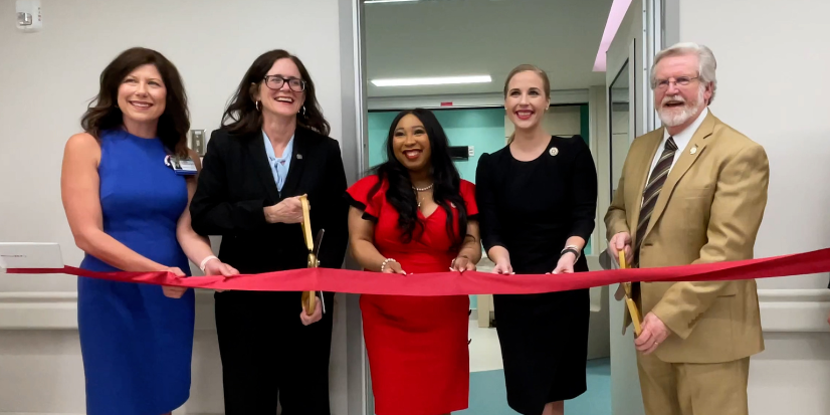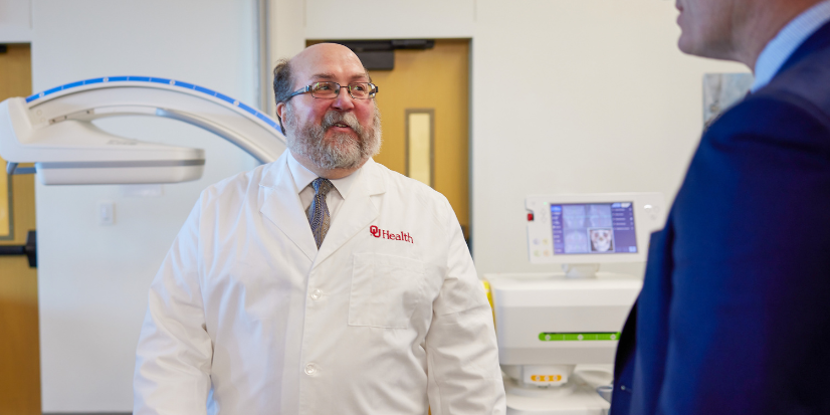Pediatric Urology Clinic Earns National Recognition For Spina Bifida Care

The pediatric urology clinic at OU Health Physicians has received a prestigious designation from the Spina Bifida Association as a Spina Bifida Clinical Care Partner.
The national association selects partners based on demonstrated commitment to the care of spina bifida patients and pursuit of continuous improvements in care. As a designated Clinical Care Partner, Oklahoma Children’s Hospital OU Health is listed as such on the national Spina Bifida Association website.
The application process began more than a year ago, spearheaded by Jennifer Cooper, MSN, APRN, Valari Cathey, APRN, CNP, and Dominic Frimberger, M.D., pediatric urologist. The application must demonstrate the applicant’s adherence to 10 best practices known to contribute to the best outcomes for people with spina bifida.
Frimberger, chief of pediatric urology at Oklahoma Children’s Hospital, said, “Often, the care of patients with spina bifida is a lifelong partnership that involves the patient’s entire family. It’s important that parents feel confident, not only in the level of care their child receives, but also that they feel supported by the highly skilled professionals who provide that care as needs evolve and change over time. Our pediatric urology clinic and Oklahoma Children’s Hospital stand alone in offering such breadth of multidisciplinary, pediatric-specific resources so essential to the care of this patient population.”
Spina bifida is a birth defect, not uncommon in the United States, occurring in one per 2,000 live births. A type of neural tube defect, it is complex and affects no two individuals in the same way. The condition develops in early-stage pregnancy, the result of incomplete closure of the spine, which leaves areas of the spinal cord and spinal nerves exposed. In its most severe form, the level of exposure makes an infant prone to life-threatening infections, and has the potential to cause paralysis and bladder and bowel dysfunction. Spina bifida is the most common birth defect affecting the central nervous system. While its causes are not entirely understood, it is believed to be influenced by both genetic and environmental factors.
“Becoming an SBA Clinical Care Partner is an honor for this clinic, and we’re excited for the benefits our patients will realize,” Cooper said. “As part of our partnership, we have established a new Spina Bifida Clinic at The Children’s Center in Bethany, which facilitates our ability to deliver the kind of sophisticated services and care for optimal outcomes.”
Cathey explained that the participation of The Children’s Center supports coordinated specialty care in a single setting. Spina bifida patients may require a broad range of care encompassing urology, neurosurgery, orthopedics, orthotics, physiatry, nutrition, therapy and social services. Working closely together, care teams address complex needs more effectively as the child grows.
“It is important to consider the impact on families – parents who miss workdays to keep medical appointments, and also bear responsibility for other children in the home, as well as the patient who misses school for multiple doctor visits. The comprehensive team approach eases these burdens. Parents have the option to select the most convenient location for their child’s care,” said Cathey.
A number of best practices required by the Spina Bifida Association have been standard at the OU Health Physicians pediatric urology clinic for years. The clinic’s active involvement with the Oklahoma Adaptive Sports Association (OKASA) is part of a longstanding tradition. With the exception of pandemic-related circumstances, the clinic has coordinated and aggressively promoted the annual Wheelchair Basketball Tournament, which pairs physician, executive and administrative teams competing in wheelchairs, against the athletes who make up OKASA teams. Many are patients seen at the OU Health Physicians pediatric urology clinic. The highly successful fundraising event supports the athletes to make more competitive opportunities available.
The clinic also has a well-established transition program that strategically maps the course of care as patients become adults with different care needs. REACH Clinic incorporates four levels of transition, which begin at age 16. Its purpose is to provide urological care that meets the needs of adolescents and young adults diagnosed with chronic childhood conditions, including but not limited to spina bifida, spinal cord injury, cerebral palsy, bladder exstrophy, and other genetic, neurological or congenital conditions. The goal is to prevent urgent urological healthcare issues and creates a bridge that helps patients transition smoothly from pediatric to adult healthcare services. In this way, this vulnerable patient population finds support throughout the lifespan.
Other required SBA Standards of Care include:
- Adherence to spina-bifida specific patient care guidelines.
- Leadership of a medical director with expertise in medical or surgical disciplines. If the medical director has a surgical background, the clinic must further demonstrate partnership with a provider from physiatry or medicine (general pediatrics, developmental pediatrics, internal medicine, internal medicine/pediatrics, or family medicine) to ensure that the person’s comprehensive needs are met.
- In addition to a medical director, the clinical care team must include a nurse or nurse practitioner. The clinic care team collaborates with identified specialists who have expertise and interest in comprehensively treating people using the Guidelines for the Care of People with Spina Bifida.
- Care is coordinated and integrated for each patient through designated personnel available five days per week during regular business hours. In some practices, care coordination is shared among several staff members. Coordination of care includes, but is not limited to:
- Communication among providers of care, including the primary care physician.
- Creation of a written plan of care shared between the patients, family and healthcare team.
- Scheduling tests, obtaining and communicating results to the provider, and other relevant steps.
- Incorporating performance measures of care coordination and care integration.
- Implementing processes to receive and address urgent and emergency calls/care outside normal business hours.
- Engagement in activities that promote knowledge and/or promote the improvement of care of people spina bifida.
- Within a year of application, clinics that serve newborns will work to establish relationships with prenatal spina bifida diagnosis programs, and consult with families to present diagnoses in a standardized way.
- Development and implementation of strategies for transition from pediatric to adult care.
- Engagement in a variety of activities or programming options that support he Spina Bifida Collaborative Care Network (SBCCN). Initiatives include but are not limited to community/awareness events, continuing education opportunities and conferences.
- Creation of a Patient Advisory Committee, including patients and their families, to be convened within one year of application.
In keeping with the Spina Bifida Association standards of care and best practices, the OU Health Physicians pediatric urology clinic launched a Patient Advisory Committee, currently comprised of eight families. The group held its first meeting in April and will meet regularly with the support of the clinic to offer feedback based on patient/family experiences and highlight opportunities for improvement. The PAC strives to represent ethnic diversity, geographic distribution and treatment modalities.
“We are so excited for this opportunity to offer much sought-after care, delivered by an exceptional healthcare team. Our patients with spina bifida and their families in our state are thrilled for what it means for them,” Cooper said.


